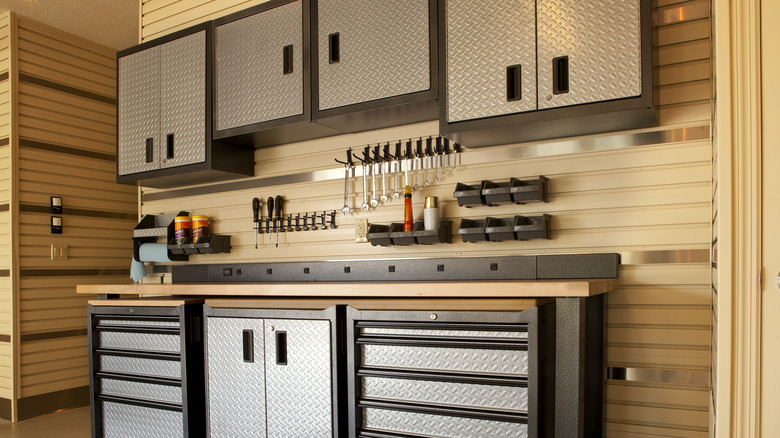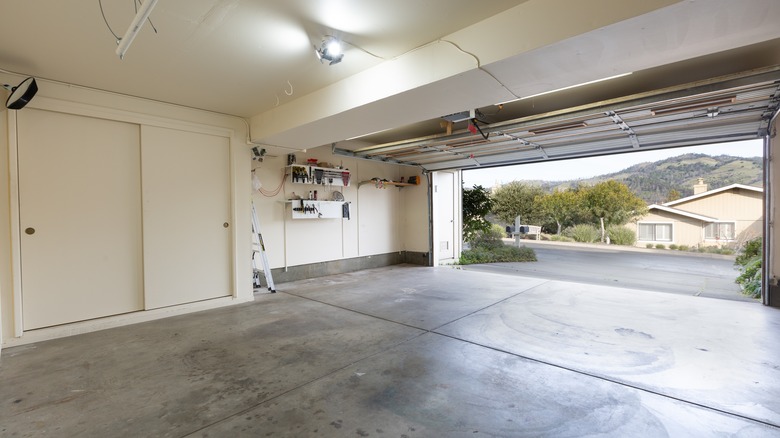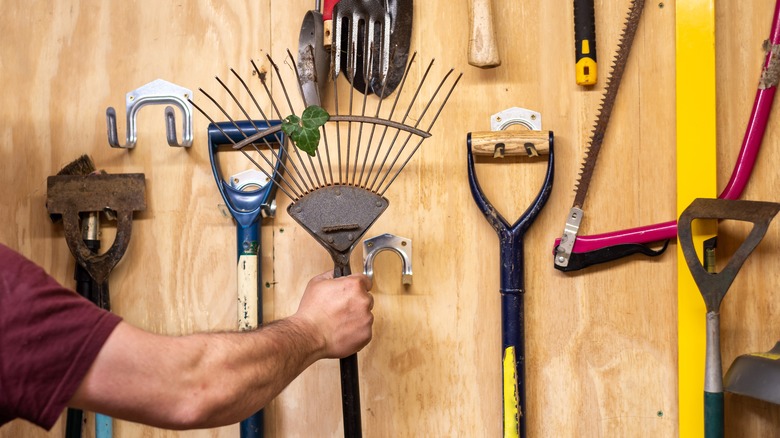How To Organize Your Garage Like A Professional, According To An Expert
Even if your home is perfectly organized, there's a good chance that your garage still remains somewhat chaotic. There are several reasons for that. Since it's not decorated like the rest of your home, you may simply not be as devoted to finding aesthetic solutions or storing things out of sight. It's also a space that serves many functions, from containing seasonal items you only need occasionally throughout the year to storing items you intend to recycle, donate, or just toss in the trash.
"The garage is one of the rooms that holds the heaviest items in your house and has the most versatility of design options because of its typically bare but very strong walls. But it is also the place that is the most vulnerable because it is typically not well-insulated or has gaps where air and critters can get in," adds Stephanie Y. Deininger, MBA, CPO, and founder of The Organized Flamingo.
It can be hard to know where to start. You need regular-use items to be accessible and rarely-used items to be neatly tucked away, but you also need to consider things like the unique location of your garage when considering storage solutions. In an exclusive interview with House Digest, Deininger shares exactly how to organize your garage for professional-looking results.
Make a list and clear the space
There's an important step to take before figuring out the optimal places for your items. "First, we recommend making a list of what you will be keeping in there. Make sure you know what you use the garage for. This will help you determine what kind of organizing system will be best," suggests Deininger.
That doesn't mean doing a quick walk-through to visually assess things — you must catalog what you're working with. "Take everything out, or as much as possible that you have the ability to carry," advises Deininger. "This is one of those spaces where you truly will want as many of the items out so you can see what you have. That can help you group the items together and is also a good opportunity to sweep and clean."
Grouping is a handy step because it'll allow you to recognize your unique storage needs. For example, if you have a ton of seasonal sports items, one wall could be devoted to storage solutions that keep your equipment tidy and protected. If your area gets varied weather throughout the year, you may want a flexible way to store summer and winter tools so you can swap them seasonally and keep the necessary items accessible. "Some of the groupings I would consider for this space are: by function or trade, woodwork items together, car parts together, garden items, exercise items, and household tools," recommends Deininger.
Declutter your stuff and measure the space
Once you've made a list of all the items in your garage that may need organizing, take some time to decide whether there are unnecessary items that are contributing to the chaos. "This is the prime time for you to declutter and decide what you don't need or needs to be thrown out," says Deininger. "Now that things are out, it's easier to part ways because you see how clutter-free your garage can be. This also is a great time to take pictures and list items in local marketplaces to sell or give away."
Then, with the unnecessary clutter removed, Deininger recommends assessing the larger items that may be more challenging to fit neatly in your garage. "While everything is out, you will want to measure the space and the bigger items. This includes your car(s), cabinets, refrigerator, sporting equipment, etc.," advises Deininger. "These are the items you will put back first and you want to make sure they all fit well like a puzzle piece. Resist the temptation to block doorways to cabinets and refrigerators." After you have a blueprint for where the bulky items will go, assess the leftover space and design your perfect small storage solutions. Measuring these remaining areas is also key if you're adding shelving, cabinets, mounts, or any other storage that needs to fit precisely in the space.
Let's get vertical
If you're feeling discouraged and like there simply isn't enough space to fit everything you want to store, there's a good chance you're only viewing the available horizontal space — according to Deininger, you need to consider all the options available. "One of my favorite ways to organize the garage is to take advantage of the vertical space," she suggests. "Not everything has to be on the floor."
It's important to keep potential vertical or overhead options in mind when measuring the space and large items and planning where you'll store everything. "As you put things back, knowing the size of the items will help you determine what can be placed there. Think lightweight items but big in size like a fishing pole or decor," recommends Deininger.
While a vertical option that requires pulling out a ladder may not be the most convenient choice for an item you need daily or even weekly, going vertical can be a fantastic way to keep less frequently used items relatively accessible. "Look for organizing solutions that will help you store things you don't use all the time (such as seasonal items) out of your everyday path," suggests Deininger.
The one major thing to keep in mind when implementing vertical storage solutions is safety. "Just make sure you can get to it easily when needed," warns Deininger. "If you decide to go vertical, just have a safe way to get to the top of things like a stool, a ladder or pulley system to bring the items back down."



